With B2B marketing automation, you can serve the right content to the right person at the right time – at scale. You can also drive consistency and efficiency with internal processes. And not to mention, it just might be my favorite tool in our marketing tech stack.
So, how does marketing automation apply in the real world? Here are some of our top tried and true must-have B2B marketing automation examples.
What is B2B Marketing Automation?
Marketing automation is a technology that allows you to automate, streamline, and measure your marketing tasks and workflows.
However, its true power comes through sales and marketing alignment combined with a well-utilized B2B CRM.
Sales & Marketing Alignment in Automation
If it feels like your sales and marketing teams are on different planets, adding automation to the mix won’t solve that. Ensure your teams align by outlining responsibilities, defining key terms like lead statuses and lifecycle stages, and aligning your team goals.
Reaching total harmony among teams can be a process, but at a minimum, it should be an active joint effort.
B2B Marketing Examples for Sales Collaboration and Internal Processes
Marketing automation helps to facilitate collaboration between sales and marketing in real time. It’s the conduit between the two teams. These processes within B2B businesses center around sales collaboration and the facilitation of internal processes.
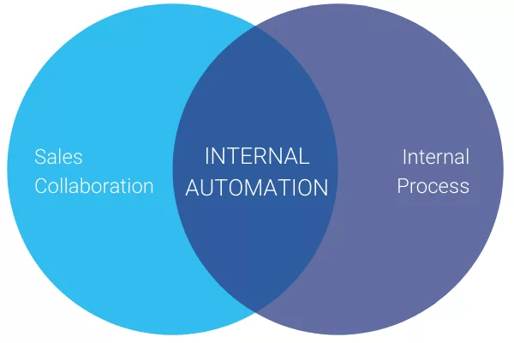
Automation for Sales Collaboration
Sales collaboration occurs in various ways, but some of the marketing automation examples outlined below are the most common.
Lead Scoring
Not all leads are created equal, and for that very reason, we leverage lead scoring. Lead scoring ranks lead readiness to convert based on the lead’s behavior. The idea behind lead scoring is that a lead can take specific actions or engagements which speak to their sales readiness. For example, a user who is highly engaged on the site, downloading multiple offers, visiting key pages (like pricing), and signing up for the blog, etc., is, in theory, more ready to purchase than a user who visited one or two pages on the site a couple of times.
Lead scoring allows a sales and marketing team to work together to develop criteria identifying leads likely to purchase so that Sales can follow up with them. How to do this will be different for each CRM. In HubSpot, you set up your behaviors and scores and then create a workflow or a list to send all leads who meet your threshold to sales automatically.
Setting Leads to Marketing Qualified & Assigning to Sales
This next section applies to setting any lifecycle stage or lead status. However, we’ll focus on Marketing Qualified Leads because that lifecycle stage is a must and a big factor in measuring marketing ROI.
Again each CRM will be different, but in HubSpot, our favorite way to achieve this is by creating an MQL List. The list includes all of our specific MQL criteria like the following:
- The role is (insert the desired role)
- The company name is known
- The phone number is known
- The industry is (insert the desired industry)
- And the lead source is none of offline
Note: MQL criteria setting is part of the sales & marketing alignment process and should be revisited at a minimum twice a year.
Once your list is built with your set criteria, you can create a workflow that notifies sales or makes a task for the MQL to be reviewed by sales.
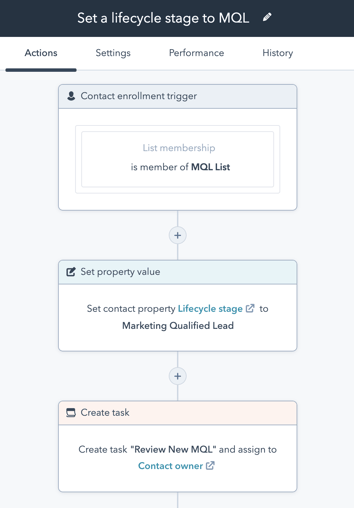
Recommended Reading: 5 Ways Marketing Automation Can Boost Lead Volume
Automation for Internal Processes
B2B companies often have complex business processes. B2B marketing automation can drive efficiencies and allow real-time routing, task creation, and follow-up across functions and channels.
Lead Routing
Is your sales team divided into territories or divided by certain products, services, or areas of expertise? If so, lead routing is your ticket to removing the manual review of leads and automatically routing by key differentiators. You’ll always start with a form submission and follow with if/then branches or conditionals to route leads.
For example: If a contact fills out the “Demo Request” form and their country is set to the U.S., then assign Frank as the contact owner and create a task for Frank to review.
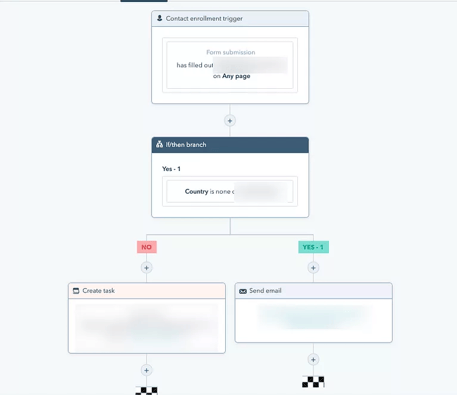
Data Governance/Management
It’s also common that workflows be used to ensure your CRM stays up to date and with as many properties completed as possible. We can use workflows to manage some of the following:
- Subscription Types: If contacts fill out forms such as a newsletter sign-up, a webinar, product updates, etc. You can manage their subscriptions on the back end with workflows.
- Opt-Outs: If you want to keep a running master opt-out list, you can create a workflow that states if a contact opts out of communication, add them to a specific list.
- Contact Owners: Similar to the lead routing scenario, you can use workflows to ensure all contacts have an owner. Or, if they don’t, use a workflow to create a task for a sales leader to review.
Copying Across Property Types: This might vary depending on your CRM, but you are likely using different types of properties or objects to store your data. For example, a company record or contact record. In some cases, the information should be the same in both places. Rather than duplicating efforts, use a workflow to copy the value from one property to another.
B2B Marketing Automation Examples for Lead Nurturing
Lead nurturing is cultivating relationships with potential buyers at every stage of the sales process and through the buyer’s journey. It focuses on meeting buyers where they are, listening, and providing helpful, relevant information.
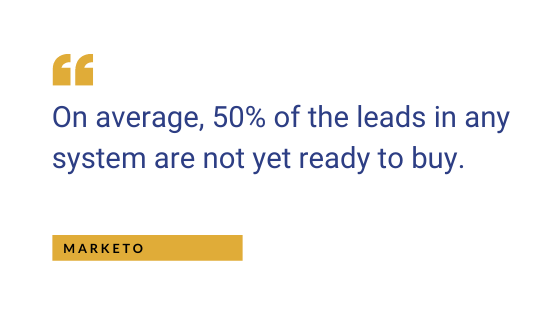
B2B marketing automation allows you to create lead nurturing campaigns, also known as email drip campaigns. These are a series of emails spread over time that help buyers move from awareness to consideration to decision.
When it comes to what emails to include, how many, and what frequency, it depends on your persona’s needs, your buying cycle, and the action the contact took. Nurturing campaigns are not ‘set it and forget it.’ Email open rates and engagement through marketing attribution reporting will be your workflow gut check and point you toward areas for optimization.
Lead to MQL Nurturing & Beyond
Lead to MQL nurturing is a common point in the buyer’s journey in which nurturing can start. It is initiated by a contact downloading a piece of content. From there, you offer the lead relevant information that may help them solve the pain point that initially brought them to your site. Along the way, you give them plenty of opportunities to convert with additional content and CTAs.
The goal is to nurture the lead until they become a Marketing Qualified Lead and meets your set criteria. From there, queue sales!
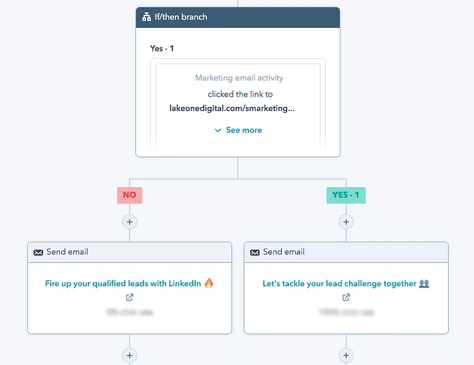
Form Submission Follow-Up
Depending on the type of form a contact submits, you might not need a full-blown workflow, maybe a simple thank you will suffice? If so, workflows are your ticket. They can easily go from a 10-email sequence, as mentioned above, to a one-and-done thank you for your submission email.
Pro Tip: Take your ‘Contact Us’ form submissions to the next level by sending a follow-up email post submission letting your contacts know when they can expect to hear from you in response to their inquiry.
Date-Based Marketing Automations
If you have a CRM like HubSpot, workflows don’t have to be based solely on a contact property; they can be date-based too! This is perfect for webinars, trade shows, and other events. Date-based workflows can handle the following:
- Leading up to an event
- During an event
- Post-event follow up
Marketing Automation Optimizations
Okay, you set up all of the B2B marketing automation above. That means you’re done and can move on to the next initiative, right?
If the ‘how about no sloth’ didn’t give it away, the answer is ‘no.’ The setup is only the beginning. Sales and marketing automation tools typically come with better reporting capabilities, and you should totally use them. Whether it’s lead flows, MQLs, or subscriptions, reviewing and optimizing your B2B marketing automation workflows are a must.
Also, it’s worth noting that a part of the story can’t always be seen in the data. Take the time to talk to the teams and solicit feedback. Is automation working? Is it missing the mark? Meeting on a regular cadence will help uncover those issues too.
Lake One Can Help With B2B Marketing Automation
So tell us, did you like the examples? Are we missing one of your favorites? Sales and marketing automation can save you time and help your B2B business scale. We’d love to chat if you’re considering incorporating automation into your sales and marketing strategy.


